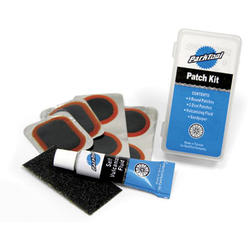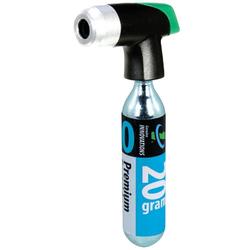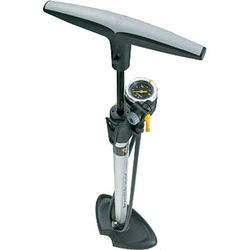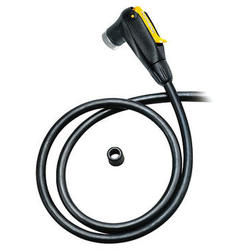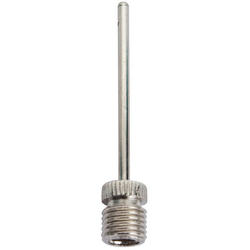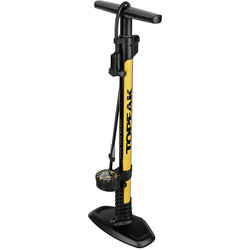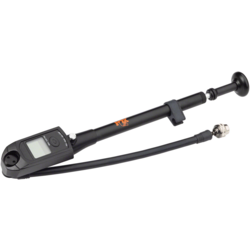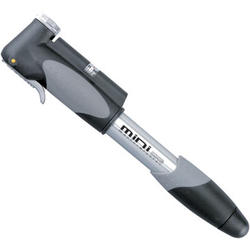
How To Fix A Flat Bike Tire Guide
Sooner or later, you'll ride over some glass or perhaps hit a rut or hole and get a flat tire. When this happens, don't panic! As long as you carry a few basic tools (which we can help you with), flat repair is easy—even fun! Here's how it's done. Note that these instructions are for standard tires and tubes, and tubeless setups, and for road and mountain bicycles, too. 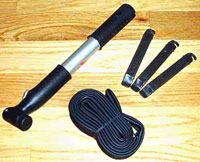
First, you'll need (photo) a pump (one that's right for your valve type and that's carried on your bike or in a pack), a spare tube (to replace the popped one) and tire levers (for removing the tire). Carry the tire levers and spare tube in a seat bag or your hydration pack. Most pumps can be frame mounted for carrying or you can tuck it in your pack if you carry one, too.
When you get a flat there are usually six easy steps to follow to fix it.
1. Open the brake (you skip this step if your bike has disc brakes because it's unnecessary).
2. Remove the wheel.
3. Remove the tire and tube.
4. Inspect the tire and remove whatever caused the flat (if it's still there).
5. Install the tube (spare) and tire.
6. Inflate and seat the tire and reinstall the wheel.
Here are complete instructions for each of these simple steps. Note that, while we've tried hard to answer every possible question you could have about flat tire repair, you only need to read as much as you want. And, be sure to click on the many underlined links and the photos for larger photos and additional helpful tips.
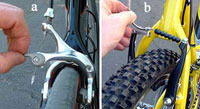 1. Open the brake: As soon as you get that "sinking" feeling or hear the hiss of escaping air, let your ride partners know you have a flat (so they won't disappear over the horizon) and stop in a safe spot. If it's a rear flat, shift onto the smallest rear cog. The first step in wheel removal (except for bikes with disc brakes) is opening the brake, which makes it easier to get the wheel out (photo: click to enlarge).
1. Open the brake: As soon as you get that "sinking" feeling or hear the hiss of escaping air, let your ride partners know you have a flat (so they won't disappear over the horizon) and stop in a safe spot. If it's a rear flat, shift onto the smallest rear cog. The first step in wheel removal (except for bikes with disc brakes) is opening the brake, which makes it easier to get the wheel out (photo: click to enlarge).
Open sidepull brakes by fully rotating the little lever on the brake upwards (a). Open linear-pulls (also called "direct-pulls" or "V-brakes") by lifting the end of the "noodle" out of its holder (b). Some sidepulls are opened by pressing a button on the lever. Look for this if there's no lever on the brake. Open cantilever brakes (these feature a cable that runs over the top of the tire) by lifting the cable end on one side out of its holder.
Tips
- Be safe! Work off the road/trail so a semi doesn't flatten you!
- While it's possible to get the wheel with the flat out without opening the brake, it won't be so easy reinstalling the wheel when it's fully inflated. That's why we recommend opening the brake first.
- If you have disc brakes, there's nothing to open. The wheel will come right out of the brake with no muss, no fuss. Cool. The only thing to watch out for is to never squeeze the disc-brake lever when the wheel is out of the frame because that will close the brake pads and you'll need to then spread them.
 2. Remove the wheel: Open the quick release (or loosen the axle nuts) on the wheel with the flat and lift the bike to remove the wheel. To extract rear wheels, it helps to pull the derailleur back slightly to clear the axle parts as the wheel passes through (main photo: click to enlarge). For fronts, you'll probably need to hold one side of the quick release and turn the other counterclockwise to create clearance to get past the wheel-retention ("safety") tabs on the fork (inset photo: click to enlarge).
2. Remove the wheel: Open the quick release (or loosen the axle nuts) on the wheel with the flat and lift the bike to remove the wheel. To extract rear wheels, it helps to pull the derailleur back slightly to clear the axle parts as the wheel passes through (main photo: click to enlarge). For fronts, you'll probably need to hold one side of the quick release and turn the other counterclockwise to create clearance to get past the wheel-retention ("safety") tabs on the fork (inset photo: click to enlarge).
Tips
- Never force the wheel out! If it's stuck, determine what's holding it in place and free it.
- When the wheel is out of the frame, lay the bike on its left side, or have a friend hold it, so you don't damage the derailleur or get dirt in the drivetrain.
- Resist the temptation to turn the bike upside-down as this can damage certain brake/shift levers (if dirt were to get inside), your cyclo-computer (scratches), and it increases the likelihood of the bike falling and getting damaged especially if traffic is passing.
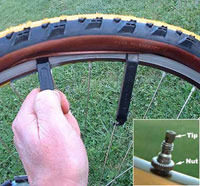 3. Remove the tire and tube: Remove the valve cap and nut (sometimes found on Presta valves: inset photo: click to enlarge). For Presta valves, unscrew the tip and press down to let all the air out. For Schraders, poke the end of the tire lever into the valve to release all the air. Starting directly opposite the valve, wiggle a tire lever beneath the tire's edge and pry down to lift. If possible, hook the lever on a spoke (many levers are made to do this), or hold it in place. Place another lever about 4 inches away from the first and pry here (main photo: click to enlarge). Continue with your third lever until you can get one side of the tire off. Then reach inside and fully extract the tube. Pull the other side of the tire off the same side of the wheel or pry it off with the levers.
3. Remove the tire and tube: Remove the valve cap and nut (sometimes found on Presta valves: inset photo: click to enlarge). For Presta valves, unscrew the tip and press down to let all the air out. For Schraders, poke the end of the tire lever into the valve to release all the air. Starting directly opposite the valve, wiggle a tire lever beneath the tire's edge and pry down to lift. If possible, hook the lever on a spoke (many levers are made to do this), or hold it in place. Place another lever about 4 inches away from the first and pry here (main photo: click to enlarge). Continue with your third lever until you can get one side of the tire off. Then reach inside and fully extract the tube. Pull the other side of the tire off the same side of the wheel or pry it off with the levers.
Tips
- If you have trouble getting the tire off, make sure all the air is out of it. Even a little air can make the tire a lot tighter.
- Some cyclists prefer to remove only one side of the tire to ease reinstallation. The disadvantage is that it's harder to check inside the tire to find whatever popped the tube and also to check inside the rim to see if the rim strip is still covering all the sharp spoke holes (sometimes it gets shifted out of place over time).
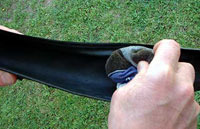 4. Inspect the tire: It's important to find whatever caused the flat and remove it. If you don't, the culprit might still be in the tire where it'll just pop your new tube! To find it, remove your glove (or use a rag), and run it around inside the tire in both directions (photo: click to enlarge). If something sharp is still stuck in your tire, it'll snag the glove. Remove the nasty. If you can't find anything, it's likely it got knocked out during the disassembly procedure.
4. Inspect the tire: It's important to find whatever caused the flat and remove it. If you don't, the culprit might still be in the tire where it'll just pop your new tube! To find it, remove your glove (or use a rag), and run it around inside the tire in both directions (photo: click to enlarge). If something sharp is still stuck in your tire, it'll snag the glove. Remove the nasty. If you can't find anything, it's likely it got knocked out during the disassembly procedure.
Tips
- Be sure to check inside the rim, too. The rim strip covering the sharp spoke holes (and sometimes the spoke nipples), can move, which allows the tube to be cut. Make sure that the rim strip covers completely.
- As long as the hole in the tire is about 1/4-inch long or less, you'll be okay reusing the tire.
- If the tire has a large gash in it, you'll need to patch it somehow before reinstallation. Paper money works great. Simply place it over the hole as you install the tire and tube. It'll reinforce the tire at the hole and get you home (you can also buy or make and carry tire patches out of rubber or stout cloth like denim, canvas or nylon; cyclists call these simple tire patches "tire boots"). If there's a big hole in a tire, the boot will work for a while but you should replace the tire ASAP.
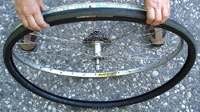 5. Install the tube & tire: 4 Easy Steps
5. Install the tube & tire: 4 Easy Steps
1) Inflate the new tube just enough to round it out and remove any wrinkles, and place it inside the tire. Then, stand the wheel up (rest it against your shins if needed) so that the valve hole is on top, and hold the tire/tube over the wheel so that the valve is on top (photo: click to enlarge).
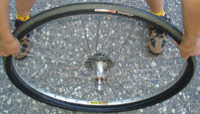 2) Place the valve partway into the hole and simultaneously push the top section of the tire edge (called the "bead") that's at the valve and closest to your legs onto the rim. Then, with both hands moving downward away from the valve using the ground to push against, finish working the bottom tire bead (the one closest to your legs) onto the wheel all the way around the wheel (photo: click to enlarge).
2) Place the valve partway into the hole and simultaneously push the top section of the tire edge (called the "bead") that's at the valve and closest to your legs onto the rim. Then, with both hands moving downward away from the valve using the ground to push against, finish working the bottom tire bead (the one closest to your legs) onto the wheel all the way around the wheel (photo: click to enlarge).
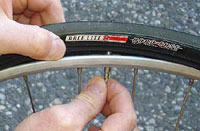 3) With one bead in place, tuck the tube fully inside the tire and on top of the rim, which will cause the other bead to rest flush against the rim. Work this bead on starting at the valve as you did with the first. To get the bead started, you may have to push the valve into the tire to provide clearance for the bead (photo). Once you've got the bead started, work your hands away from the valve pressing the bead onto the rim around the wheel as you did in step 2 above.
3) With one bead in place, tuck the tube fully inside the tire and on top of the rim, which will cause the other bead to rest flush against the rim. Work this bead on starting at the valve as you did with the first. To get the bead started, you may have to push the valve into the tire to provide clearance for the bead (photo). Once you've got the bead started, work your hands away from the valve pressing the bead onto the rim around the wheel as you did in step 2 above.
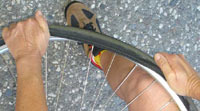 4) With a few inches of bead left to pop onto the rim, the tire will resist. Let all the air out. Crouch and rest the wheel on your knee to have something to push against. Now, hold the bead in place with one hand (we're using our left hand in the photo: click to enlarge) and with your stronger hand, push down to roll the stubborn section onto the rim with the heel of your hand. But don't try to pop it on all at once. Install an inch at a time, moving your hand along until you've fully installed the tire. If it resists, be sure all the air is out of the tire. Got it? Good job!
4) With a few inches of bead left to pop onto the rim, the tire will resist. Let all the air out. Crouch and rest the wheel on your knee to have something to push against. Now, hold the bead in place with one hand (we're using our left hand in the photo: click to enlarge) and with your stronger hand, push down to roll the stubborn section onto the rim with the heel of your hand. But don't try to pop it on all at once. Install an inch at a time, moving your hand along until you've fully installed the tire. If it resists, be sure all the air is out of the tire. Got it? Good job!
Tips
- Make sure that your spare tube's valve is the right type for your wheel.
- Tubes that are slightly narrower than the tire fit fine and are easiest to install (for example: use a 700 x 20c tube in a 25c tire and a 1.5-inch tube in a 1.9-inch tire).
- A trick to create slack and ease tire installation is to go around the rim squeezing the tire beads into the rim's center (the deepest portion), which increases the slack between the tire and wheel.
- During tire installation, if you locate the tire label at the valve, you'll have a reference point when searching the tire for what popped the tube when you get a flat.
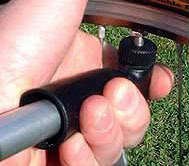 6. Inflate and seat the tire and reinstall the wheel: Place your pump on the valve and inflate the tire. To prevent valve damage, brace the valve by wrapping a finger behind a spoke and your thumb over the tire (photo: click to enlarge) so you're pushing against your hand, not the valve. And hold the pump steady, don't wiggle it around as you pump. Inflate the tire until it's just firm (not fully inflated). At this point, inspect the tire to make sure it's "seated," which means that it's sitting correctly on the wheel.
6. Inflate and seat the tire and reinstall the wheel: Place your pump on the valve and inflate the tire. To prevent valve damage, brace the valve by wrapping a finger behind a spoke and your thumb over the tire (photo: click to enlarge) so you're pushing against your hand, not the valve. And hold the pump steady, don't wiggle it around as you pump. Inflate the tire until it's just firm (not fully inflated). At this point, inspect the tire to make sure it's "seated," which means that it's sitting correctly on the wheel.
If the tube gets trapped beneath a bead (photo, below, left: click to enlarge), inflating further may blow the tire and tube off the rim! There are bead lines on the sides of the tire that should be equidistant from the rim all 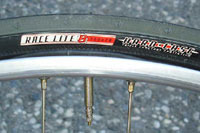 the way around on both sides of the wheel. If they're not, or if you see a section of tube peeking out from under the tire (photo), let the air out, poke the tube gently back into place with your tire lever (don't even think of using a screwdriver, which will pop the tube), reinflate partway and check the tire again.
the way around on both sides of the wheel. If they're not, or if you see a section of tube peeking out from under the tire (photo), let the air out, poke the tube gently back into place with your tire lever (don't even think of using a screwdriver, which will pop the tube), reinflate partway and check the tire again.
When it's seated correctly, inflate the tire fully. Install the valve nut (if your tube uses one) and cap finger tight (overtightening the valve nut can damage the tube and make it difficult to loosen it when you need to fix a flat). Reinstall the wheel in the frame, close the brake quick release or reattach the noodle or cable and you're ready to ride!
Tips
- Not all portable pumps have the power to fully inflate all tires. But that's okay. You only need enough air to make the tire firm enough to ride on. If you can't get it hard enough to finish your ride, find a bike shop or head home to fix it properly.
- The first time you fix a flat it may take 30 minutes to an hour. But, with practice, you'll get much faster. Experienced cyclists can easily repair one in 10 minutes.
- If you ride regularly and haven't fixed a flat yet, practice at home to build your confidence.
From the best pumps, to spare tubes, patch kits and flat-resistant tires and tubes, we have everything you need to ensure that you have a minimum of flat tires and an easy time fixing flats, too. We can also show you how to fix a flat. Just ask if you need any help at all. Thanks!
Thanks to Park Bike Tools for this great video!

